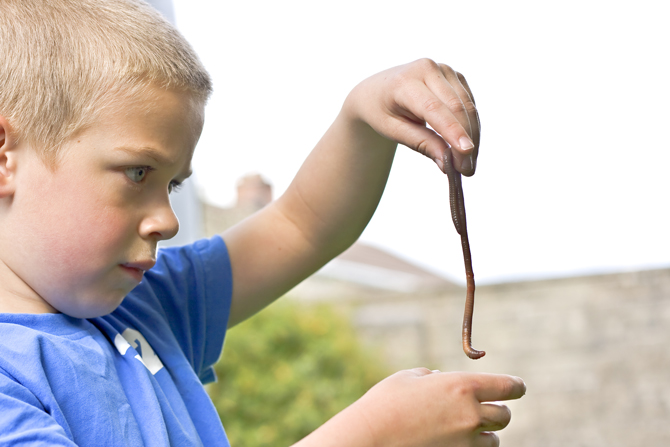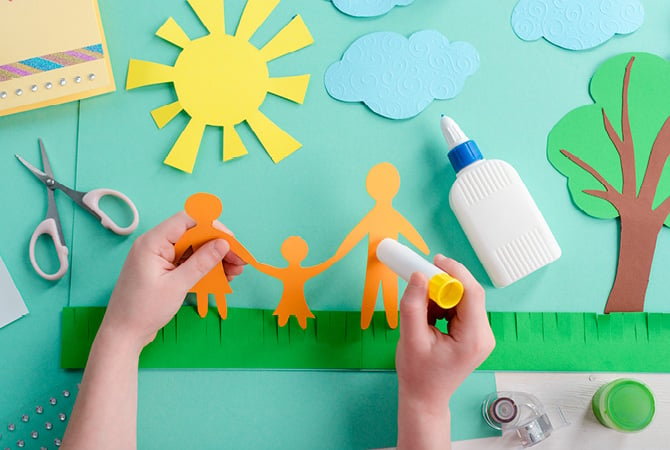Movement and Games
1. Just a Minute!
This activity fosters coordination and motor skills.
Materials: space (indoor or outdoor), timer or clock
Challenge your child to see how many jumping jacks they can do in a minute. Before they start, have them predict how many they will be able to do. Can they do as many as they thought?
Then have your child try it with other kinds of movements too, like push-ups, sit-ups, or arm circles. This is a great activity to return to day after day. Can kids beat their own records?
2. Splish Splash
This activity fosters coordination and motor skills.
Materials: outdoor space, plastic bottle filled with water, plastic cup. Optional: measuring tape or ruler; household objects like kitchen tongs, spoons, pens, etc.
Place an empty plastic cup on the ground about 10 feet away. (If you do not have a measuring tape or a ruler, 10 feet is about twice as long as your child from head to toe!) Give your child the bottle of water and tell them to carry it to the cup and pour the water in without using their hands! They can use other parts of their body, like their elbows, knees, or lips. Or they can try carrying it with household objects like tongs or two spoons. Have your child keep trying until they are able to carry the water all the way or until they spill it all!
3. Freeze Dance
This activity fosters coordination and motor skills.
Materials: music, space (indoor or outdoor)
Play your child’s favorite song. Have them dance while the music plays and pause the music at random points. Tell them they must freeze in place each time the music stops.” Keep going until the song ends.

4. How Many Skips?
This activity supports estimation and counting skills.
Materials: space (indoor or outdoor)
Have your child guess how many skips it will take for them to get from one place to another (for example, from one room to another or from one outdoor landmark to another). Then they should actually skip between the two places and keep count to see how close their guess was!
5. Up/Down/Left/Right
This activity fosters coordination and motor skills.
Materials: space (indoor or outdoor)
Have your child pretend they’re in an endless runner video game. Have them jog in place while you call out directions. When you call out up or down, your child should jump or duck, respectively. If you call out left or right, your child should turn and face that direction. See how long your child can go without getting all mixed up!
6. Animal Walk
This activity fosters motor skills.
Materials: space (indoor or outdoor)
Go for a walk with your child and, along the way, have them move like different animals (for example, hop like a bunny, scurry like a crab, or run like a cheetah)!

7. Mirror, Mirror
This activity improves concentration.
Materials: none
Have your child stand face-to-face with someone else.
Choose who will be Person A and who will be Person B. Person A will be the “mover” first. Person A will start out with small movements, like wiggling their nose. Then Person A will try bigger movements, like swinging an arm from side to side. Person B must follow Person A’s movements EXACTLY. It should look like Person A is looking in a mirror!
Then switch! Person B will be the “mover.” Person A will follow their every move.
8. Find the Rhymes
This activity promotes literacy.
Materials: none
Ask your child to choose one thing around the home that has a simple name. For example: door, cat, or bed.
Your child will then walk around your home and find other things that rhyme with that word. For example, if they chose a “bed,” they might find a “sled” or some “bread” in the home too!
Your child can play this indoors or outdoors.
9. Guess the Animal
This activity fosters coordination and creativity.
Materials: none
Have your child act out different animals for other people in your family to guess.
Have one child think of an animal. They will act like this animal for one minute without making any sound. Can anyone guess which animal they are being?
After one minute, if the animal has not been correctly guessed, your child can make noises too (but NO words!).
Tip: If thinking of different animals will be difficult, write down the names of several animals on small strips of paper. Put the strips in a container and have your child pick one out!
Science and Nature
1. Worm Investigation
This activity is a scientific investigation with movement included!
Materials: backyard dirt, a stick, damp paper towels, paper and pencil
Go outside and gently dig up worms. Put a worm on a damp paper towel. Have your child observe how it moves. Then they can draw a picture and write a few sentences about it. Challenge your child to move like worm too!

2. Ant Observation
This activity encourages observation.
Materials: cookie or something sweet to crumble, paper, pencils
Go outside. Crumble a cookie onto a patio or picnic table. Do any ants come to it? What do they do? Have your child draw a picture of an ant carrying a cookie crumb. Then have them write a sentence or a story about what the ant did!
3. Measuring Cups/Spoons
This activity provides a hands-on precursor to fractions (shh!).
Materials: bowl of water, measuring cups and spoons
Set your child up at the sink or outside. Fill a ¼ cup measuring cup with water and pour it into a larger measuring cup. Predict: How many times will you have to do this to fill the larger cup? Try it and count as you go. Then try it with different-sized cups and spoons.
4. How Many Pennies?
This activity improves math and engineering skills.
Materials: tinfoil, pennies, paper (optional)
Cut a piece of tinfoil for your child. Have them fold up the sides so that the foil looks like a boat.
Fill up the bathroom sink, the tub, or a large bowl with water. Test out the boat—make sure it floats!
Then get the pennies. Have your child add the pennies one by one into the boat. See how many pennies can be added before the boat sinks. Record your findings on a piece of paper!
Tip: Try making different boats to see which one will hold the most pennies. Ask your child why they think one particular boat held more pennies than the others.
Art and Imaginative Play
1. Pasta Jewelry
This activity provides practice with patterns—the foundation of math!
Materials: tubular pasta, string or cord, markers
Let your child color tubular shapes of pasta with markers. Then lace them onto a string. Make different patterns. Have children tell you about the patterns they’re making.
2. Fly Your Flag
This activity encourages creativity and artistic expression.
Materials: paper, art supplies
Have your child make a flag that represents them! Encourage them to think about what colors, shapes, and symbols best show who they are as a person. When they have finished their flag, have them come up with words to a “national anthem”! They can sing it to the tune of a popular song like “Twinkle, Twinkle Little Star” or “The Itsy Bitsy Spider.”
3. Hey, Neighbor!
This activity fosters creativity and empathy.
Materials: paper, art supplies
Point out to your child that a lot of people are staying home right now and can’t play with their friends and neighbors. Ask your child: What is a message or a wish you would like to share with the people in our community? Then have them make a sign to share that message with your neighbors. Put the sign in your window or in your front yard so that other people who are staying home can see it when they look outside. And when you look outside, see if you can spot signs or messages that other people have made!

4. Extra, Extra!
This activity builds writing skills and imagination.
Materials: paper and art supplies or a computer
Have your child write a newspaper about your home or community! Encourage them to include multiple sections, like in a grown-up’s newspaper.
Local News: What’s been happening in your home since you’ve been home? You're your child interview you and other family members. (For “national/international news,” have them call friends relatives who live in other places!)
Arts: Have them review a movie you’ve watched together.
Sports: Have you played any sports or games together? Have them write up a summary of how the game went and who won.
Editorials: What is something that your child has a strong opinion about? What is something they would like to change? Have them write an opinion piece about it!
Food: What is the best meal your child has eaten since they’ve been at home? What is their dream meal?

5. One-Word Story
This activity fosters creativity and imagination.
Materials: two or more people
Starting with “Once upon a time,” go back and forth with your child, one word at a time, to make up an entire story together!
6. Weird Menu!
This activity fosters creativity and gets the sillies out.
Materials: none
Your child will pretend to be a waiter. Someone else will be the customer. Have your child think of the weirdest (or grossest) foods possible! Then they should tell the “customer” about the food. For example, they might say:
Welcome to our restaurant. Tonight we are serving . . .
- pizza topped with oatmeal and fish sticks
- chicken-‘n’-dirt nuggets
- hot dog topped with whipped cream
- a broccoli ice cream sundae
The challenge is to say the gross foods without laughing!
All images: Shutterstock.com




